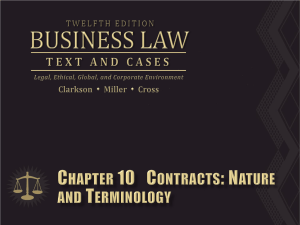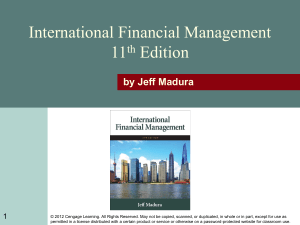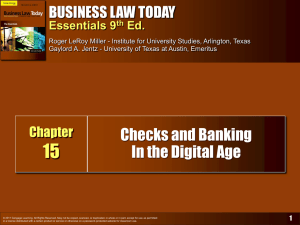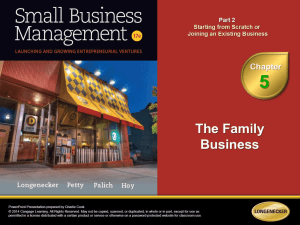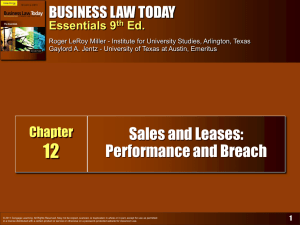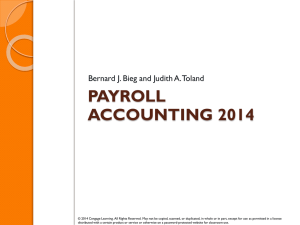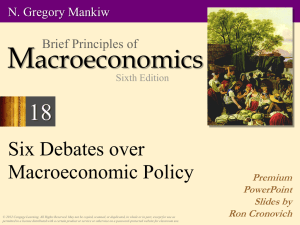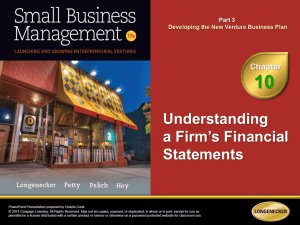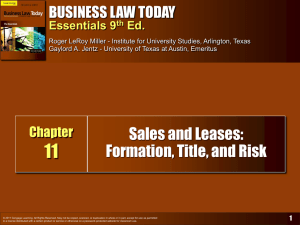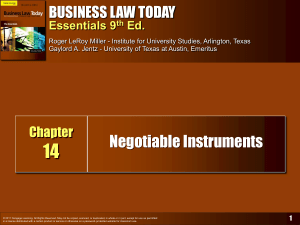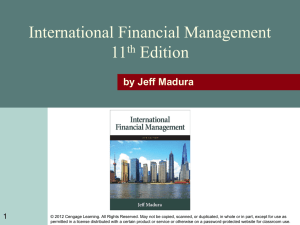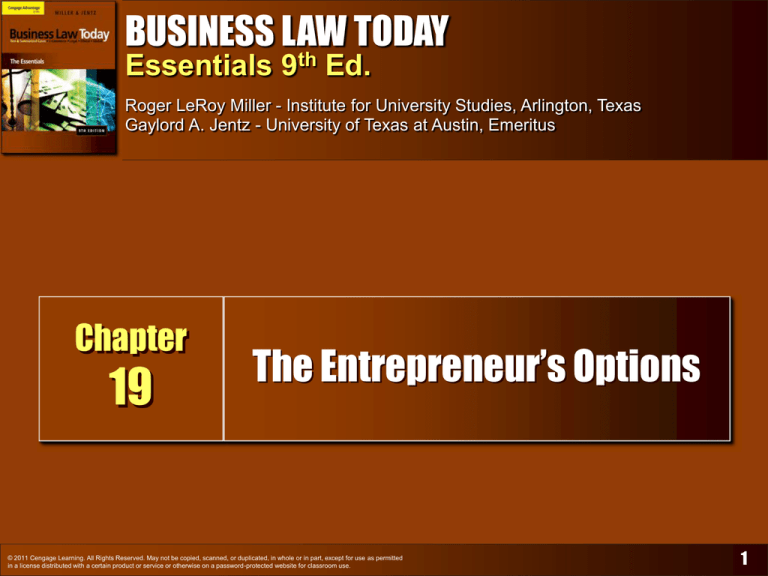
BUSINESS LAW TODAY
Essentials 9th Ed.
Roger LeRoy Miller - Institute for University Studies, Arlington, Texas
Gaylord A. Jentz - University of Texas at Austin, Emeritus
Chapter
19
The Entrepreneur’s Options
© 2011 Cengage Learning. All Rights Reserved. May not be copied, scanned, or duplicated, in whole or in part, except for use as permitted
in a license distributed with a certain product or service or otherwise on a password-protected website for classroom use.
1
Learning Objectives
What are some of the major forms of business
organization used by entrepreneurs in the
United States?
What advantage and disadvantage are
associated with each major business form?
Why have limited liability companies and
limited liability partnerships come into
widespread use in recent years?
What is a joint venture? What are some other
special business organizational forms, and
why are they used?
What is a franchise, and how does a
franchising relationship arise?
© 2011 Cengage Learning. All Rights Reserved. May not be copied, scanned, or duplicated, in whole or in part, except for use as permitted
in a license distributed with a certain product or service or otherwise on a password-protected website for classroom use.
2
Introduction
Entrepreneurs wishing to start a new
business must be aware of advantages
and disadvantages of various business
entities for their endeavor. Consider:
Ease of creation.
Owners’ liability.
Tax considerations.
Need for Capital.
© 2011 Cengage Learning. All Rights Reserved. May not be copied, scanned, or duplicated, in whole or in part, except for use as permitted
in a license distributed with a certain product or service or otherwise on a password-protected website for classroom use.
3
Sole Proprietorships
The owner is the business itself; anyone who
does business without creating a separate legal
business organization is a sole proprietorship.
Advantages
Disadvantages
Owner is in complete
control & receives all
profits
Flexibility
Owner is personally liable
for all torts/contracts
Ease of creation;
maintenance
Difficult to raise financing
Lacks continuity after
death
© 2011 Cengage Learning. All Rights Reserved. May not be copied, scanned, or duplicated, in whole or in part, except for use as permitted
in a license distributed with a certain product or service or otherwise on a password-protected website for classroom use.
4
Partnerships
Partnership arises from agreement, express
or implied, between two or more persons to
carry on a business together for profit.
Partners are agents and fiduciaries of one
another, but differ from agents in that they
are also co-owners and have equal rights to
manage and share in the profits and losses.
If a commercial enterprise shares profits and
losses, a partnership will be inferred.
Law: Uniform Partnership Act.
© 2011 Cengage Learning. All Rights Reserved. May not be copied, scanned, or duplicated, in whole or in part, except for use as permitted
in a license distributed with a certain product or service or otherwise on a password-protected website for classroom use.
5
Uniform Partnership Act
In the absence of an express partnership
agreement (oral or written) most states
have enacted the UPA to govern the rights
among partners:
Management: equal, each one vote, majority
wins; need unanimous consent for some
actions.
Partnership Interest: equal profits, losses
shared as profits shared.
© 2011 Cengage Learning. All Rights Reserved. May not be copied, scanned, or duplicated, in whole or in part, except for use as permitted
in a license distributed with a certain product or service or otherwise on a password-protected website for classroom use.
6
When Does a Partnership Exist?
Intent to associate is a key element of a
partnership, and all “partners” must
consent.
Three key elements:
A sharing of profits and losses, AND
A joint ownership of the business, AND
An equal right to be involved in the
management of the business.
© 2011 Cengage Learning. All Rights Reserved. May not be copied, scanned, or duplicated, in whole or in part, except for use as permitted
in a license distributed with a certain product or service or otherwise on a password-protected website for classroom use.
7
Partnership Formation
Generally, agreements to form a
partnership can be:
Oral.
Written, or
Implied by Conduct.
Duration.
Partnership agreement can specify duration.
If limited, called “Partnership for a Term.”
© 2011 Cengage Learning. All Rights Reserved. May not be copied, scanned, or duplicated, in whole or in part, except for use as permitted
in a license distributed with a certain product or service or otherwise on a password-protected website for classroom use.
8
Partnership Formation
Partnership agreements (Articles of
Partnership) should be written.
Partners must have legal capacity. UPA
permits corporations to be a partner.
Partnership By Estoppel: parties who
are not partners hold themselves out to
3rd Parties and 3rd Party relies to her
detriment.
© 2011 Cengage Learning. All Rights Reserved. May not be copied, scanned, or duplicated, in whole or in part, except for use as permitted
in a license distributed with a certain product or service or otherwise on a password-protected website for classroom use.
9
Rights of Partners
Management: equal, each one vote,
majority wins; need unanimous consent
for some actions.
Partnership Interest: equal profits, losses
shared as profits shared.
Compensation: generally, none.
© 2011 Cengage Learning. All Rights Reserved. May not be copied, scanned, or duplicated, in whole or in part, except for use as permitted
in a license distributed with a certain product or service or otherwise on a password-protected website for classroom use.
10
Rights of Partners
Inspection of the Books: always and also
by rep. of deceased partner.
Accounting: when other partner(s)
committing fraud, embezzlement,
wrongful exclusion, or anytime it is just
and reasonable.
Property Rights
© 2011 Cengage Learning. All Rights Reserved. May not be copied, scanned, or duplicated, in whole or in part, except for use as permitted
in a license distributed with a certain product or service or otherwise on a password-protected website for classroom use.
11
Rights of Partners
Each partner has a property right,
which includes:
An interest in the partnership.
A right in specific partnership property.
A right to participate in the management of the
partnership, as mentioned above.
© 2011 Cengage Learning. All Rights Reserved. May not be copied, scanned, or duplicated, in whole or in part, except for use as permitted
in a license distributed with a certain product or service or otherwise on a password-protected website for classroom use.
12
Duties and Liabilities of Partners
Fiduciary Duties: Partners are fiduciaries
and general agents of one another and
the partnership.
Authority of Partners: Partners have
implied authority to conduct ordinary
partnership business but need
unanimous consent to sell assets or
donate to charity.
Scope of Implied Powers.
Authorized vs. Unauthorized Actions.
© 2011 Cengage Learning. All Rights Reserved. May not be copied, scanned, or duplicated, in whole or in part, except for use as permitted
in a license distributed with a certain product or service or otherwise on a password-protected website for classroom use.
13
Liabilities of Partners
Joint Liability for Contracts.
If Partner is
sued for Partnership debt, Partner has right
to insist that other partners be sued with
her.
Joint and Several Liability for Torts: 3rd
party can sue either one or all partners. 3rd
party may collect against personal assets of
all partners.
Liability of Incoming Partner. Newly
admitted partner has no personal liability for
existing partnership debts and obligations.
© 2011 Cengage Learning. All Rights Reserved. May not be copied, scanned, or duplicated, in whole or in part, except for use as permitted
in a license distributed with a certain product or service or otherwise on a password-protected website for classroom use.
14
Limited Partnerships
Agreement of two or more persons to
carry on a business for profit with at
least one general partner and one
limited partner.
Limits the liability of the limited
partners to their investment.
An LP is a creature of state statute so
filing a certificate with the Secretary of
State is required.
© 2011 Cengage Learning. All Rights Reserved. May not be copied, scanned, or duplicated, in whole or in part, except for use as permitted
in a license distributed with a certain product or service or otherwise on a password-protected website for classroom use.
15
LP - Rights and Liabilities
The General partner assumes all
management and personal liability.
Both general and limited partners have a
fiduciary duty to each other.
CASE 19.1 1515 North Wells, LP v. 1513
North Wells, LLC. An LP agreement cannot
contract away the fiduciary duties. So a general
partner is liable for breach of fiduciary duty to
limited partners.
© 2011 Cengage Learning. All Rights Reserved. May not be copied, scanned, or duplicated, in whole or in part, except for use as permitted
in a license distributed with a certain product or service or otherwise on a password-protected website for classroom use.
16
LP - Rights and Liabilities
General partners are personally liable to 3rd
parties for breach of contract and tort liability.
A corporation (or an LLC) can be a general
partner and with limited liability.
Limited Partner contributes cash but has no
management rights.
Liability is limited to the amount of investment.
A limited partner can forfeit this “veil” of
immunity by taking part in the management of
the LP.
Limited partners have the right to inspect the
LP’s books.
© 2011 Cengage Learning. All Rights Reserved. May not be copied, scanned, or duplicated, in whole or in part, except for use as permitted
in a license distributed with a certain product or service or otherwise on a password-protected website for classroom use.
17
Corporations
Corporation is the most widely used
business form in the United States.
Creature of statute (must be formed by
state agency, usually secretary of state).
Corporations are owned by
shareholders, managed by directors and
officers.
Limits shareholder liability to investment.
More details in Chapter 20.
© 2011 Cengage Learning. All Rights Reserved. May not be copied, scanned, or duplicated, in whole or in part, except for use as permitted
in a license distributed with a certain product or service or otherwise on a password-protected website for classroom use.
18
Limited Liability Companies
LLC’s are creatures of state law, like
corporations.
Owners are called “members” (not
shareholders) and their ownership is
called an “interest” (not shares).
Members of an LLC enjoy limited
liability.
LLC’s can sue and be sued by
employees or third parties.
© 2011 Cengage Learning. All Rights Reserved. May not be copied, scanned, or duplicated, in whole or in part, except for use as permitted
in a license distributed with a certain product or service or otherwise on a password-protected website for classroom use.
19
LLC Articles of Organization
Articles of Organization require:
Name of Business.
Principal Address.
Name and Address of Registered Agent.
Names of the Owners; and
How the LLC will be managed.
Business name must include “LLC” or
“Limited Liability Company.”
© 2011 Cengage Learning. All Rights Reserved. May not be copied, scanned, or duplicated, in whole or in part, except for use as permitted
in a license distributed with a certain product or service or otherwise on a password-protected website for classroom use.
20
LLC Limited Liability
LLC, as a legal entity, is liable for acts of
members and LLC obligations.
However, members are not personally
liable for LLC obligations, and are only
liable up to their investments.
CASE 19.2 Allen v. Dackman (2009).
Owner of interests in an LLC is not the legal
“owner” of real property and not personally
liable for injuries to tenants on property owned
by LLC.
© 2011 Cengage Learning. All Rights Reserved. May not be copied, scanned, or duplicated, in whole or in part, except for use as permitted
in a license distributed with a certain product or service or otherwise on a password-protected website for classroom use.
21
Operating an LLC
Operating agreement is analogous to
corporation’s bylaws.
Operating agreements may be oral and
contain provisions relating to
management, dividends, meetings,
transfer of membership interests, and
other significant issues.
Generally, if the operating agreement is
silent, courts will apply partnership
principles.
© 2011 Cengage Learning. All Rights Reserved. May not be copied, scanned, or duplicated, in whole or in part, except for use as permitted
in a license distributed with a certain product or service or otherwise on a password-protected website for classroom use.
22
Management of an LLC
There are two options for management,
generally set forth in the articles of
organization:
Member-Managed: all of the members participate in
management, like a partnership.
Manager-Managed: members are elected to manage
the LLC.
If the articles are silent, statutes provide
either that each member has one vote or
votes are made based on percentage of
ownership.
© 2011 Cengage Learning. All Rights Reserved. May not be copied, scanned, or duplicated, in whole or in part, except for use as permitted
in a license distributed with a certain product or service or otherwise on a password-protected website for classroom use.
23
LLC - Advantages and Disadvantages
Advantages
Disadvantages
Member liability is limited to
amount of investment. (see
Case 28.3 below)
State statutes are not uniform.
Can be treated as a “pass
through” entity for tax
purposes.
Not all states recognize LLC’s.
Profits can be distributed to
members without the double
taxation of a corporation.
Members pay personal income
tax on received dividends.
© 2011 Cengage Learning. All Rights Reserved. May not be copied, scanned, or duplicated, in whole or in part, except for use as permitted
in a license distributed with a certain product or service or otherwise on a password-protected website for classroom use.
24
Limited Liability Partnerships
LLP: hybrid form of business that
allows for ‘pass-through’ for tax
purposes, but limits personal liability
from malpractice of other partners.
LLP is formed under state law.
Family LLP is a limited liability
partnership in which the majority of the
partners are related to each other.
Used frequently for agriculture.
© 2011 Cengage Learning. All Rights Reserved. May not be copied, scanned, or duplicated, in whole or in part, except for use as permitted
in a license distributed with a certain product or service or otherwise on a password-protected website for classroom use.
25
Special Business Forms
Joint Venture: two or more entities
combine efforts or property for a single
transaction or project.
Unless agreed otherwise, JV’s share profits and
losses equally.
Common in international transactions when
U.S. companies wish to expand overseas.
© 2011 Cengage Learning. All Rights Reserved. May not be copied, scanned, or duplicated, in whole or in part, except for use as permitted
in a license distributed with a certain product or service or otherwise on a password-protected website for classroom use.
26
JV Characteristics
Resembles a partnership and is taxed like a
partnership. However, a JV is limited in time
and scope, whereas a partnership is an
ongoing business. Other differences:
JV members has less implied and apparent authority
than partners.
Death of JV member does not terminate JV.
JV members can specify duration.
If not,
then JV terminates when purpose is
accomplished.
© 2011 Cengage Learning. All Rights Reserved. May not be copied, scanned, or duplicated, in whole or in part, except for use as permitted
in a license distributed with a certain product or service or otherwise on a password-protected website for classroom use.
27
Special Business Forms
Syndicates.
Investment group of individuals/firms who
finance a project together.
Joint Stock Companies.
Hybrid of partnership and corporation, with
many similarities of partnership.
Business Trusts.
Created by private agreement with
beneficiaries.
Cooperatives.
© 2011 Cengage Learning. All Rights Reserved. May not be copied, scanned, or duplicated, in whole or in part, except for use as permitted
in a license distributed with a certain product or service or otherwise on a password-protected website for classroom use.
28
Franchises
Franchise is an arrangement between a
Franchisor (owner of a trademark or
trade name) and a Franchisee can sell
goods or services.
25% of all retail sales based on franchise
merchandising.
© 2011 Cengage Learning. All Rights Reserved. May not be copied, scanned, or duplicated, in whole or in part, except for use as permitted
in a license distributed with a certain product or service or otherwise on a password-protected website for classroom use.
29
Types of Franchises
Distributorship.
Involves licensing a product and may include a
territory.
Chain-Style Business Operation.
Involves licensing a trademark (or brand).
Franchisee required to followed standardized
operations and quality control.
Sometimes franchisee may be required to buy
supplies from franchisor.
Manufacturing or Processing Plant.
Involves essential ingredients or formula to make a
product.
© 2011 Cengage Learning. All Rights Reserved. May not be copied, scanned, or duplicated, in whole or in part, except for use as permitted
in a license distributed with a certain product or service or otherwise on a password-protected website for classroom use.
30
Laws Governing Franchising
Generally governed by contract law.
If involves sale of goods over $500, UCC
Article 2 applies.
Federal Regulation of Franchising.
FTC “Franchise Rule” requires certain material
disclosures.
State Regulation.
Often involves bad faith and deceptive
practices.
© 2011 Cengage Learning. All Rights Reserved. May not be copied, scanned, or duplicated, in whole or in part, except for use as permitted
in a license distributed with a certain product or service or otherwise on a password-protected website for classroom use.
31
The Franchise Contract
Key Provisions:
Payment.
Business Premises and Organization.
Location of the Franchise.
Quality Control (key issue).
Pricing Arrangements (including supplies from
franchisor).
© 2011 Cengage Learning. All Rights Reserved. May not be copied, scanned, or duplicated, in whole or in part, except for use as permitted
in a license distributed with a certain product or service or otherwise on a password-protected website for classroom use.
32
Termination of the Franchise
Duration is determined by contract.
Notice is by contract, or within a reasonable
time.
Franchisor can give franchisee an opportunity
to “cure” an ordinary breach, but not a
material breach.
CASE 19.3 LJL Transportation, Inc. v. Pilot Air
Freight Corp. (2009). Even though a franchise
contract contains a “right-to-cure” clause, a
franchisee’s material breach of contract can justify
immediate termination of contract.
© 2011 Cengage Learning. All Rights Reserved. May not be copied, scanned, or duplicated, in whole or in part, except for use as permitted
in a license distributed with a certain product or service or otherwise on a password-protected website for classroom use.
33
Termination of the Franchise
Wrongful Termination.
Favor franchisor.
Federal and state laws attempt to protect
franchisee from arbitrary and unfair actions.
Importance of Good Faith and Fair Dealing.
© 2011 Cengage Learning. All Rights Reserved. May not be copied, scanned, or duplicated, in whole or in part, except for use as permitted
in a license distributed with a certain product or service or otherwise on a password-protected website for classroom use.
34

